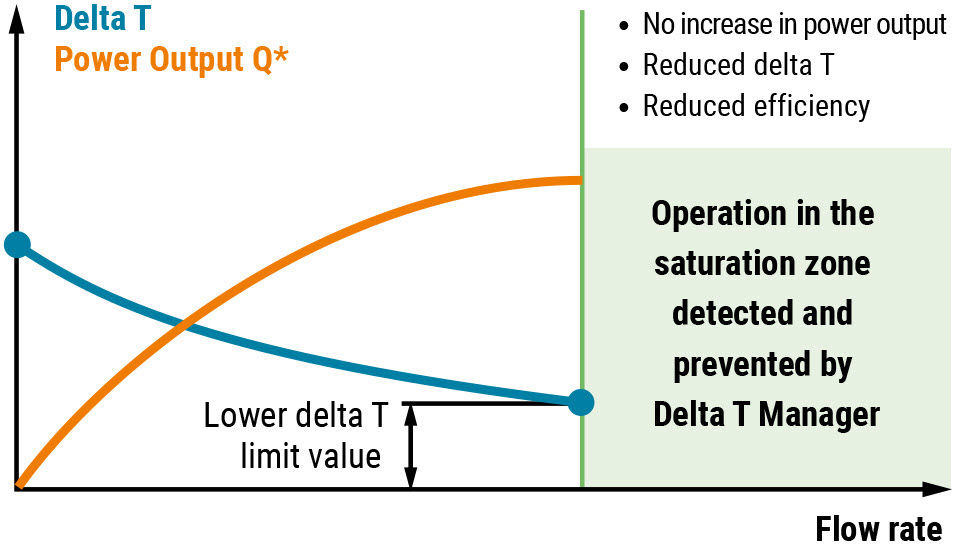

Belimo Energy Valve™ in Two Pipe Change Over
¿Qué es un sistema de dos tuberías con changeover (TPCO)?
Los sistemas de dos tuberías con changeover (TPCO) se utilizan normalmente cuando resulta demasiado caro el uso de conjuntos dobles de tuberías para cada consumidor, o cuando se espera que habrá un número reducido de días en los que las unidades realmente se utilizarán para la calefacción. Con un conjunto único de tuberías, la unidad sólo puede calentar o enfriar en un momento determinado.
Normalmente, se espera que el ambiente tenga algún tipo de calefacción de respaldo (normalmente elementos eléctricos) para utilizarla cuando el sistema está en el modo de refrigeración y cuando solo un número reducido de zonas requiere calefacción.
Los sistemas TPCO pueden ser utilizados para:
- Unidades de fan and coil
- Vigas frías
- Techos de enfriamiento
- Suelo radiante (mayoritariamente en edificios residenciales)
Esquema
La imagen muestra una configuración condensada con una unidad terminal. No obstante, la aplicación de válvulas EV en lugar de válvulas de control estándar permite a los constructores especialmente, utilizar el diseño de dos tuberías de menor costo, a la vez que se alcanza el mismo nivel de confort asociado a los sistemas de cuatro tuberías. Las Energy Valves pueden actualizarse con diferentes valores de referencia de flujo y de diferencial de temperatura para el enfriamiento y la calefacción; en efecto, el sistema de administración de edificios es capaz de hacer que la misma válvula actúe como dos válvulas diferentes.
Problema: fluctuaciones de presión que afectan a los flujos y el confort
Los grandes sistemas de agua helada son dinámicos por naturaleza y sufren fluctuaciones de presión causadas por la velocidad de la bomba y los cambios de la posición de la válvula. Los sistemas con balanceo estático, como el propio nombre sugiere, son incapaces de ocuparse de estos cambios dinámicos y, por tanto, los flujos a través de cada unidad fluctúan con los cambios de presión.
Posible solución: balanceo dinámico
La función de balanceo dinámico de la válvula independiente de la presión se ocupa, precisamente, de dichas fluctuaciones de presión en el sistema y garantiza que el flujo se mantenga en el valor de referencia definido.

Order the new Belimo Energy Valve™ now
Learn how the Energy Valve improves your two pipe change over system

Problemas comunes en sistemas de dos tuberías con changeover y cómo los aborda la Belimo Energy Valve™
Problem: Poor performance in heating mode
Heat exchangers or coils are typically selected on cooling loads, meaning that if the water medium is simply switched from cold to warm, the design flow rates are no longer suitable. For example, a typical cooling delta T would be 7 K, while you would expect a heating delta T of at least twice that.
Solution: Adjustable flow rates for heating/cooling season
As an intelligent valve is capable of high level communication with the BMS, flow rates can be updated remotely. This allows a change in design flow rates to be applied so that the valve is always controlling to the optimum flow rate.
Problem: Low delta T syndrome
As the heat exchanger is not only experiencing a change in water temperature, it could be experiencing a change in air volume in line with the new mode. With multiple variables of the heat exchange fluctuating, it now becomes virtually impossible to completely predict the correct flow rate over the range of permitted flows.

Solution: Energy Valve using the Delta T Manager
The Delta T Manager, integrated in the Belimo Energy Valve™, is a function that continuously measures the temperature spread and compares it with the systemspecific limiting value. If it falls below this, the Belimo Energy Valve™ automatically adjusts the flow so that only the amount of water actually needed is allowed through the heat exchanger. It is possible to update the required delta T using the bus interface, as easily as the water flows, giving you complete control.

Consejo profesional
La Energy Valve también registra el uso de la energía de calefacción y enfriamiento por separado, por lo que, en lugar de comprar dos medidores, uno para la calefacción y uno para el enfriamiento, ahora sólo necesita una unidad.
Ejemplo de aplicación
The example shown in the figure depicts a traditional setup with a flow rate of 0.11 l/s [1.74 GPM], based on the required cooling power, given inlet temperatures 6 °C [43 °F] and outlet temperature 12 °C [54 °F]. The heating flow rate required for the space is 0.05 l/s [0.79 GPM]. However, the system is set to deliver 0.11 l/s [1.74 GPM]. As a result, the heating performance is largely on/off.
This works to a degree, but the poor delta T experienced during the heating phase typically makes this setup incompatible with condensing boilers, because the return temperatures are too high for them to condense. As the heat exchanger is given the same fl ow rate of 0.11 l/s [1.74 GPM] when heating, the water is unable to give up sufficient energy to air, resulting in high return water temperatures or low delta T, as shown in fi gure 106.
As there are no PI valves fi tted to this solution, we still suffer with all the cross pressure fl uctuations typically seen with non-PI valve setups. This worsens the delta T further.



With the Energy Valve being updated with heating flow rates and delta T, the valve switches to 0.05 l/s [0.79 GPM] and enforces a minimum delta T of 30 K. Doing so, now allows the use of condensing boilers on the project, as the return water temperatures can be assured.


